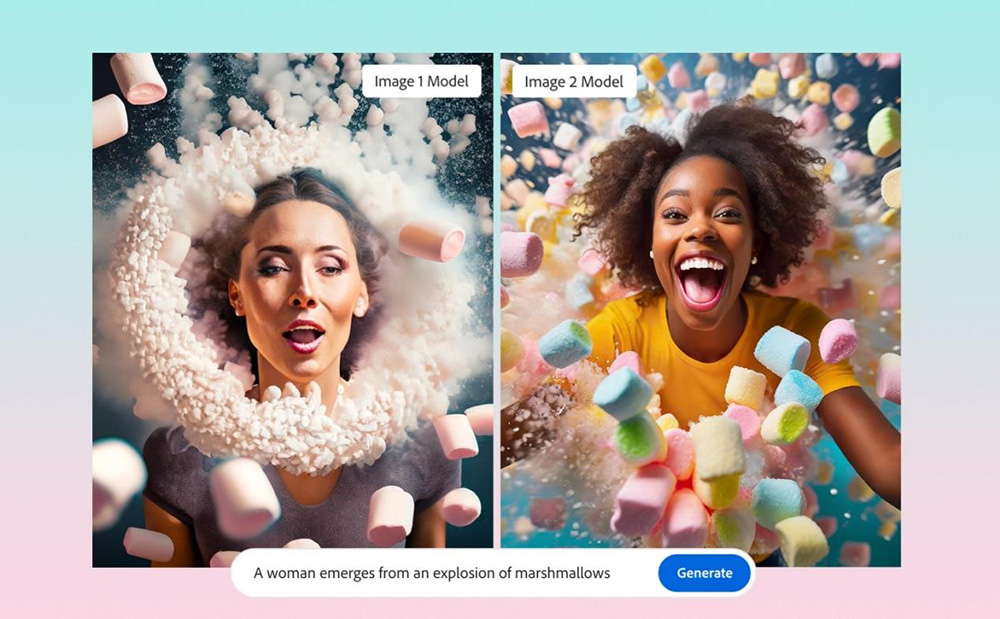
互联网上流传着数十个预测人工智能将取代工种的清单,其中平面设计师经常榜上有名。Adobe最新推出的人工智能功能或许助推了相关预测,然而该公司领导层对创意工作未来的看法有所不同。
Adobe负责数字媒体的高级副总裁阿什利·斯蒂尔表示,尽管随着图像生成领域技术发展,平面设计会变得更容易,但并不会减少艺术家的工作。“两件事可能切实发生,”她告诉《财富》杂志。“技术创新可能方便更多人自行生成图像,同时对专业人员的需求也会增加。
“想想相机的发明就能理解,”斯蒂尔说,“当时人们以为绘画会从此消失,事实并非如此。只是出现了新的内容形式。”她表示,再看别的例子,数码相机发明后更多人能拍照,然而并未取代对专业摄影师的需求。
话虽如此,未来由于平面设计团队部分工作交给人工智能完成导致团队遭公司裁员,应该不是稀罕事。最近席卷科技行业的裁员中,设计师也受到影响。如果这一规律延续,尽管人工智能不会彻底颠覆平面设计,也将极大改变行业。
周二的一场公司活动上,Adobe推出了最新一批生成式人工智能工具,主要采用新方式创建和编辑图像。新工具中包括第二代Firefly,Firefly是3月刚发布的图像生成软件。除了色彩改进和细节更准确,升级后的软件还能调整快门速度和光圈风格,就好像专业摄影师在操控相机一样。企业可以向Firefly提供一些可供参考的营销材料定制软件,以模仿品牌的视觉风格。例如,如果使用可口可乐账户生成图像,Firefly会倾向使用品牌标志性的红色。
Adobe还推出了一款文本转矢量的模型,用于创建不使用像素的标识和图标,也是平面设计中常见的艺术风格。用户可以为矢量图像生成新元素以及编辑现有元素。设计师还能利用模板生成功能创建数字邀请函、传单和小册子。
Adobe广泛推广旗下人工智能产品的同时,关键受众正是人工智能可能取代的群体——平面设计师。其中很多人工作中都在用Adobe软件,人工智能工具会自动添加。根据公司发布的订购计划,升级费用将从每月2美元涨到7.50美元。
Adobe承诺涨价物有所值。斯蒂尔表示,公司提供的人工智能产品可以通过完成日常又繁琐的任务,为设计师节省时间和精力,比如为同一图像生成不同的文件格式、修改宽高比和选择特定像素组再编辑等等。
至于商业工作方面,斯蒂尔设想Adobe的工具将允许公司内更多员工使用软件。订购计划扩大范围有望提升Adobe的收入。她说,公司仍然需要平面设计师指导人工智能,而不是彻底取代。斯蒂尔告诉《财富》杂志,设计师使用图像生成功能的结果肯定会超过普通人,因为“他们更了解如何构建想法,哪怕是通过文本提示。”不过具体公司会不会这么做,还是简单地将人工智能当成削减成本和缩减团队的借口,还尚未可知。(财富中文网)
译者:夏林
Adobe的Firefly 2模型中人物面部特征比Firefly 1更准确。
互联网上流传着数十个预测人工智能将取代工种的清单,其中平面设计师经常榜上有名。Adobe最新推出的人工智能功能或许助推了相关预测,然而该公司领导层对创意工作未来的看法有所不同。
Adobe负责数字媒体的高级副总裁阿什利·斯蒂尔表示,尽管随着图像生成领域技术发展,平面设计会变得更容易,但并不会减少艺术家的工作。“两件事可能切实发生,”她告诉《财富》杂志。“技术创新可能方便更多人自行生成图像,同时对专业人员的需求也会增加。
“想想相机的发明就能理解,”斯蒂尔说,“当时人们以为绘画会从此消失,事实并非如此。只是出现了新的内容形式。”她表示,再看别的例子,数码相机发明后更多人能拍照,然而并未取代对专业摄影师的需求。
话虽如此,未来由于平面设计团队部分工作交给人工智能完成导致团队遭公司裁员,应该不是稀罕事。最近席卷科技行业的裁员中,设计师也受到影响。如果这一规律延续,尽管人工智能不会彻底颠覆平面设计,也将极大改变行业。
周二的一场公司活动上,Adobe推出了最新一批生成式人工智能工具,主要采用新方式创建和编辑图像。新工具中包括第二代Firefly,Firefly是3月刚发布的图像生成软件。除了色彩改进和细节更准确,升级后的软件还能调整快门速度和光圈风格,就好像专业摄影师在操控相机一样。企业可以向Firefly提供一些可供参考的营销材料定制软件,以模仿品牌的视觉风格。例如,如果使用可口可乐账户生成图像,Firefly会倾向使用品牌标志性的红色。
Adobe还推出了一款文本转矢量的模型,用于创建不使用像素的标识和图标,也是平面设计中常见的艺术风格。用户可以为矢量图像生成新元素以及编辑现有元素。设计师还能利用模板生成功能创建数字邀请函、传单和小册子。
Adobe广泛推广旗下人工智能产品的同时,关键受众正是人工智能可能取代的群体——平面设计师。其中很多人工作中都在用Adobe软件,人工智能工具会自动添加。根据公司发布的订购计划,升级费用将从每月2美元涨到7.50美元。
Adobe承诺涨价物有所值。斯蒂尔表示,公司提供的人工智能产品可以通过完成日常又繁琐的任务,为设计师节省时间和精力,比如为同一图像生成不同的文件格式、修改宽高比和选择特定像素组再编辑等等。
至于商业工作方面,斯蒂尔设想Adobe的工具将允许公司内更多员工使用软件。订购计划扩大范围有望提升Adobe的收入。她说,公司仍然需要平面设计师指导人工智能,而不是彻底取代。斯蒂尔告诉《财富》杂志,设计师使用图像生成功能的结果肯定会超过普通人,因为“他们更了解如何构建想法,哪怕是通过文本提示。”不过具体公司会不会这么做,还是简单地将人工智能当成削减成本和缩减团队的借口,还尚未可知。(财富中文网)
译者:夏林
In the dozens of lists circulating the internet that predict which jobs artificial intelligence will replace, graphic designers are often named. Adobe’s newest AI features could move that forecast along, but the company’s leadership has another idea about the future of creative jobs.
While developments in image generation are sure to make graphic design more accessible, they don’t diminish the work of artists, according to Ashley Still, Adobe’s senior vice president of digital media. “Two things can be true,” she tells Fortune. “Technological innovations can both bring more people into the medium and increase the need for professionals.
“Think about the invention of the camera,” Still says. “People thought painting was going to go away, and it didn’t. It’s just that a new type of content emerged.” Taking it a step further, the invention of the digital camera meant more people could take photos, but it didn’t replace the need for professional photographers, Still says.
That said, it’s not difficult to imagine company layoffs in the future targeting graphic design teams that have offloaded some work to AI. In the recent layoff sweep through the tech industry, designers were among those affected. If history continues on the same course, AI won’t eradicate the graphic design profession, but it will dramatically change the industry.
Adobe’s latest batch of generative AI tools, which it introduced at a company event on Tuesday, focuses on new ways to create and edit images. Included in the announcement is the second iteration of Firefly, the image generation software released in March. Along with improved coloring and more accurate details, the upgrade comes with the ability to make shutter speed and aperture-style adjustments to pictures, as if a professional photographer was behind the camera. Businesses can customize Firefly to mimic their brand’s visual style by providing it with a few marketing materials it can use as reference. When generating images on a Coca-Cola account, for example, Firefly would lean toward using its iconic red color.
Adobe is also launching a text-to-vector model for creating logos and icons that don’t use pixels, an art style common in graphic design. Users can generate new elements for the vector image and edit existing ones. Designers are also getting access to a template generation feature to create digital invitations, fliers, and brochures.
While the company is marketing its AI products broadly, a key audience for Adobe is the very group that AI threatens to replace—graphic designers. Many already use Adobe applications to do their jobs, and the AI tools are being added automatically. The upgrade also comes with a price increase from an additional $2 to $7.50 monthly, depending on the subscriber’s plan.
Adobe promises the price hike will be worth it. Its AI products can save time and energy for designers by completing routine but cumbersome tasks, like creating different file formats for an image, changing the width to height ratio and selecting specific groups of pixels to edit, says Still.
For commercial work, the executive imagines Adobe’s tools will allow more employees throughout companies to have access to the software. The bigger subscription plans could, en masse, boost Adobe’s revenue. Rather than replacing graphic designers, companies will still need them to guide the AI, she says. Designers will always get better results using image generation than your average Joe, Still told Fortune, because “they understand how to construct an idea, even if it’s through text prompts.” Whether companies adopt this approach, instead of simply using AI as an excuse to cut costs and minimize teams, remains to be seen.






